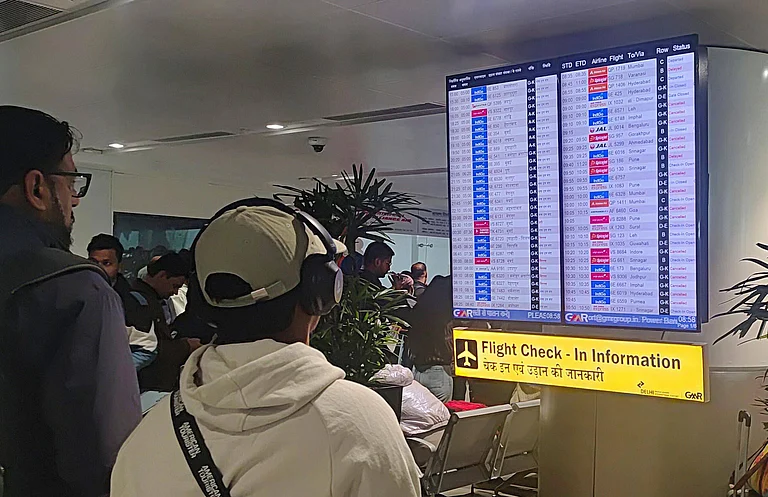The US space agency NASA on Wednesday successfully launched the Artemis I space program into space, which is the first step towards sending humans back to Moon later this decade.
After two unsuccesful launch attempts, the NASA on Wednesday launched the Space Launch System (SLS) rocket which carries the Orion spaceship on its nose. The SLS is the most powerful rocket in the world. With the launch, the Artemis I mission of the broader Artemis program is now live.
Around two hours after the SLS was launched from Kennedy Space Centre, Florida, the Orion spacecraft was injected into a wide orbit around the Moon. It will travel past the moon and cover 1.3 million miles before splashing down on Earth at the end of its 42-days journey.
Artemis I mission, comprising the Orion spacecraft, carries three human models, one of which will be in the commander's seat. These three models will be fitted with censors to check how the unprecedented space journey would affect the human body. It will help prepare for crewed missions in the next two stages of Artemis program.
The SLS was first slated to be launched in late August when the launch was cancelled after technical malfunction. The second attempt in September was called off after fuel leaks. Following these failures, the launch was delayed by safety inspection, repairs, and adverse weather.
Forced back indoors by Hurricane Ian at the end of September, the rocket stood its ground outside as Nicole swept through last week with gusts of more than 130 kph. Although the wind peeled away a 3-metre strip of caulking high up near the capsule, managers gave the green light for the launch.
What is Artemis program?
The Artemis program comprises of four missions named Artemis I, II, and III.
In Artemis I launched on Wednesday, the uncrewed spacecraft will circle the Moon to prepare for future crewed missions.
In Artemis II, the same journey would be repeated with humans on board. The mission will make history by taking humanity to the farthest point in space yet.
In Artemis III, the humans would finally land on the Moon for the first time in over 50 years.
"For the Artemis generation, this is for you,” launch director Charlie Blackwell-Thompson called out, referring to all those born after Apollo.
The liftoff marked the start of NASA's Artemis lunar-exploration programme, named after Apollo's mythological twin sister.
The space agency is aiming to send four astronauts around the moon on the next flight, in 2024, and land humans there as early as 2025.
Blackwell said, "You have earned your place in history. You're part of a first. Doesn't come along very often. Once in a career maybe. But we are all part of something incredibly special: the first launch of Artemis. The first step in returning our country to the moon and on to Mars."
The dawn of the new space age
Unlike previous Moon missions, the Artemis will not be a brief exploratory expedition. It aims at establishing a long-term presence on Moon which would be the stepping stone in the journey to Mars.
"We will collaborate with commercial and international partners and establish the first long-term presence on the Moon. Then, we will use what we learn on and around the Moon to take the next giant leap: sending the first astronauts to Mars," said NASA.
The NASA will set up a "base camp" on Moon which would allow "robots and astronauts to explore more and conduct more science than ever before".
The program is therefore much more than merely sending humans on Moon. It is extending human presence from Earth to Moon and it could possibly be the first step in turning the human race into an inter-planetory specie.
Vox explains: "The Artemis program is laying the groundwork for an unprecedented level of activity on the lunar surface, including a human base camp, a series of nuclear reactors, and a mineral mining operation. NASA has expressly said that it wants to develop a lunar economy, and the space agency has also established the Artemis Accords, a set of principles for exploring the moon that more than 20 countries have now joined."
The historic moment
NASA expected 15,000 people to jam the launch site, with thousands more lining the beaches and roads outside the gates, to witness NASA's long-awaited sequel to Project Apollo, when 12 astronauts walked on the moon during 1969-72.
Crowds also gathered outside NASA centres in Houston and Huntsville, Alabama, to watch the spectacle on giant screens.
Cheers accompanied the rocket as it rode a huge trail of flame toward space, with a half-moon glowing brightly and buildings shaking as though hit by a major quake.
Most of NASA's corps of 42 active astronauts and 10 trainees were not even born yet when Apollo 17 moonwalkers Gene Cernan and Harrison Schmitt closed out the era, 50 years ago next month.
“We are jumping out of our spacesuits with excitement," astronaut Christina Koch said Tuesday.
After a nearly yearlong space station mission and all-female spacewalk, Koch, 43, is on NASA's short list for a lunar flight.
So is astronaut Kayla Barron, 35, who finally got to witness her first rocket launch, not counting her own a year ago.
“It took my breath away, and I was tearing up,” Barron said.
"What an amazing acccomplishment for this team.”
(With AP inputs)


























